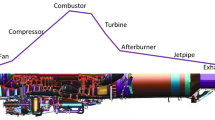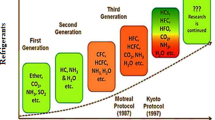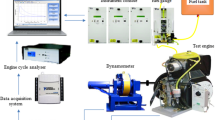Abstract
The effects of fuel/air equivalence ratio and CO2 concentration in fuel/air charge on the ignition process of gasoline and diesel-like fuel (n-heptane) blends on a rapid compression machine are investigated in this study. Results showed that the effects of equivalence ratio on ignition delays of two ignition stages are varied. As equivalence ratio increases from 0.3 to 0.5, the first stage ignition delay slightly increases because the increased equivalence ratio improves the mixture heat capacity, reducing the in-cylinder temperature and weakening the low-temperature heat release process of the fuel. The second stage ignition delay is shortened with the increased equivalence ratio because increased fuel concentration facilitates mixture reactivity. CO2 addition to the cylinder charge can effectively reduce the peak cylinder pressure and the two stage pressure rise rates, as well as extend the durations of ignition delays of two ignition stages.
Similar content being viewed by others
Reference
H. Kim, J. Ryu and K. Lee, A study on the characteristics of spray and combustion in a HCCI engine according to various injection angles and timings. Journal of Mechanical Science and Technology, 21(1) (2007) 133–140.
M. Alriksson, T. Rente and I. Denbratt, Low soot, low NOx in a heavy duty diesel using high levels of EGR, SAE technical paper, SAE 2005-01-3836.
T. Jacobs and D. Assanis, The attainment of premixed compression ignition low-temperature injection engine. Proceedings of the Combustion Institute, 31(2) (2007) 2913–2920.
N. Henein, A. Kastury and K. Natti, Advanced low temperature combustion (ALTC): diesel engine performance, fuel economy and emissions, SAE technical paper, SAE 2008-01-0652.
K. Kitano, R. Nishiumi, Y. Tsukasaki, T. Tanaka and M. Morinaga, Effects of fuel properties on premixed charge compression ignition in a direct injection diesel engine, SAE technical paper, SAE 2003-01-1815.
P. Risberg, G. Kalghatgi, H. Angstrom and F. Wahlin, Autoignition quality of diesel-like fuels in HCCI engines. SAE technical paper, SAE 2005-01-2127.
J. Kusaka, S. Kazuhiko, M. Akira and D. Yasuhiro, Study on combustion in light duty diesel engine- the effect of fuel properties for PCI (Premixed Compression Ignition) combustion. SAE technical paper, SAE 2004-08-0471.
J. Szybist and B. Bunting, Cetane number and engine speed effects on diesel HCCI performance and emissions, SAE technical paper, SAE 2005-01-3723.
G. Kalghatgi, P. Risberg and H. Angstrom, Partially premixed auto-ignition of gasoline to attain low smoke and low NOx at high load in a compression ignition engine and comparison with a diesel fuel, SAE technical paper, SAE 2007-01-0006.
G. Kalghatgi, P. Risberg and H. Angstrom, Advantages of fuels with high resistance to auto-ignition in late-injection, low-temperature, compression ignition combustion, SAE technical paper, SAE 2006-01-3385.
D. Han, A. Ickes, S. Bohac, Z. Huang and D. Assanis, Premixed low-temperature combustion of blends of diesel and gasoline in a high speed compression ignition engine, Proceedings of the Combustion Institute, 33(2) (2011) 3039–3046.
X. He, An investigation of iso-octane auto-ignition using a rapid compression facility. Ph.D. Thesis, University of Michigan, Ann Arbor, USA (2005).
D. Han, H. Guang, Z. Yang, X. Lu and Z. Huang, Premixed ignition characteristics of blends of gasoline and diesel-like fuels on a rapid compression machine, Thermal Science, 17(1) (2013) 1–10.
Author information
Authors and Affiliations
Corresponding authors
Additional information
Recommended by Associate Editor Oh Chae Kwon
Dong Han obtained his B.S. degree from Jilin University in 2005, M.S. degree from University of Michigan in 2007, and Ph.D. degree from Shanghai Jiao Tong University in 2012. Dr. Han is currently a post-doc researcher in Shanghai Jiao Tong University, Shanghai, China. His research interests include advanced engine combustion strategy development and fundamental research of fuel ignition process and chemistry.
Zhen Huang obtained his B.S., M.S. and Ph.D. degrees from Shanghai Jiao Tong University in 1982, 1984, and 1988, respectively. Dr. Huang is currently a professor in Department of Mechanical Engineering, Shanghai Jiao Tong University, Shanghai, China. His research interests cover developments of advanced engine combustion strategy, alternative fuels, and engine aftertreatment technology.
Rights and permissions
About this article
Cite this article
Han, D., Guang, H., Yang, Z. et al. Effects of equivalence ratio and carbon dioxide concentration on premixed charge compression ignition of gasoline and diesel-like fuel blends. J Mech Sci Technol 27, 2507–2512 (2013). https://doi.org/10.1007/s12206-013-0532-x
Received:
Revised:
Accepted:
Published:
Issue Date:
DOI: https://doi.org/10.1007/s12206-013-0532-x




